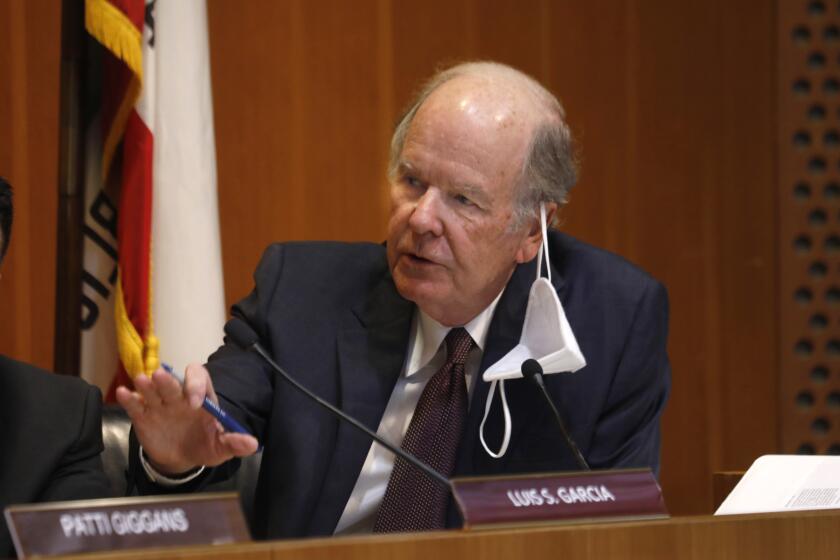Campus Choked With 70 Researchers Studying Smog
- Share via
Of all the characteristics for which the Los Angeles area is famous, probably the least likely to attract out-of-down visitors is smog.
Yet the same brown haze that is anathema to Southern Californians with sensitive eyes and lungs has drawn more than 70 scientists from the United States and Canada to a makeshift research center set up at a Citrus College parking lot in Glendora.
Titled “The Great Carbon Burn-out,” the 10-day program has brought together air-pollution researchers from seven universities, the South Coast Air Quality Management District, the U.S. Environmental Protection Agency, Canada’s Atmospheric Environment Service, and firms such as Southern California Edison, Ford Motor Co. and General Motors.
“This is probably the largest group that’s ever gotten together for this type of research,” said John Holmes, director of research for the state Air Resources Board. The board is coordinating the program, which began this week and continues through next Thursday.
The program’s purpose is to compare different methods used by pollution researchers in government, industry and academia to measure the various gases and solid particles that comprise smog. The hope is to arrive at the most accurate and cost-effective way of analyzing smog to determine its component substances and how they are formed.
“A lot of this stuff here is the best in the world,” said UC Davis physics professor Tom Cahill, scanning the dozens of prototype air filtration devices and infrared spectrometers humming busily in the parking lot. “This is really the cutting edge of aerosol science.”
The methods that prove most effective in this program will be applied in a more comprehensive smog study to be held in Los Angeles next year, Holmes said. The key now, researchers say, is to establish common procedures and a good working relationship for next year’s study.
The current study is focusing on measuring carbon compounds, particularly the black particles belched from diesel engines.
“We have more carbon soot than we did 10 years ago,” Cahill said. “It’s estimated that 30% of your haze may be carbon soot. . . . In this area, I’d say 90% of the black stuff we’re seeing is from diesels.”
Diesel-powered vehicles are not covered by the state’s mandatory Smog Check program and are not expected to be covered until the 1990s. Nonetheless, over the last several years, diesel manufacturers have been required to reduce emissions of particulates and some manufacturers are now equipping vehicles with particulate traps, which are about the size and shape of catalytic converters.
Researchers involved in the study point out that although carbon-compound particles are a primary component of visible smog, measurement of the soot is often shrouded in uncertainty.
“When you look up and you can’t see the mountains, that’s because there are particles in the air,” said Susanne Hering, a UCLA researcher monitoring the Glendora study. “Right now, there is no accepted way to measure these carbon compounds.”
Among the researchers trying to clear the air over carbon-compound measurement is Cahill, who as head of the UC Davis air-quality group helped develop a technique to measure airborne carbon particles and other pollutants in U.S. national parks.
Under Cahill’s method, air is sucked into a drum sampler and passes through a series of progressively smaller filters. The carbon soot and residue trapped in the filters form patterns that to the trained eye chronicle the origin of smog and the cyclical patterns of urban pollution.
“By classifying these particles this way, we’re able to get back to what the sources are,” Cahill said. “It also gives you an idea of how the city behaves--weekends, weekdays, morning, noon and night.”
Of course, not all air pollution is of the visible, carbon-particle variety. The air also contains hydrogen peroxide, nitric acid and formaldehyde, a suspected carcinogen. These and other invisible compounds, such as ozone, are formed when pollutants react with sunlight and organic substances in the atmosphere.
Gervase Mackay, vice president of a Toronto-based research firm, said his research here so far may not make area residents breathe easier.
“I think the nitric acid is certainly higher in the Los Angeles area than anywhere else,” he said. “You get into Pennsylvania and New York state and you get some acid deposition, but not as much as you get here. . . . And formaldehyde is certainly much higher here than anywhere else.”
But overall, researchers agree that air quality in the Los Angeles basin is actually getting better.
“Visibility here is still clearly inadequate,” Cahill said, squinting at the vague outline of the San Gabriel Mountains. “But if you want to see how the air here would have been, go to Mexico City. Without 15 years of expensive efforts, that’s what we would have here.”
Old Clunkers Hurt
Cahill said the critical reason for the improvement in Southern California air quality lies--predictably enough--with the automobile.
“The credit belongs to the people who have kept the catalytic converters on their cars and used the right gas,” Cahill said. “A small number of older cars that have slipped through the cracks are causing a disproportionate amount of the pollution. One old clunker on the highway (produces as much pollution) as 100 modern cars.”
But to continue the inroads against smog--and to make progress against acids and other invisible pollutants--millions of dollars in research and regulation are required. That, researchers say, is why it is crucial that they find the most effective way of measuring smog.
“Most of the inexpensive pollution control methods have already been implemented,” Hering said. “We certainly don’t want to have a control imposed that is not cost-effective and does not do what it’s supposed to do, because we all end up paying for controls.”
More to Read
Sign up for Essential California
The most important California stories and recommendations in your inbox every morning.
You may occasionally receive promotional content from the Los Angeles Times.













